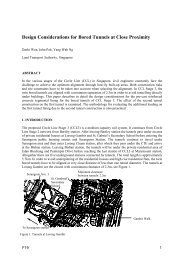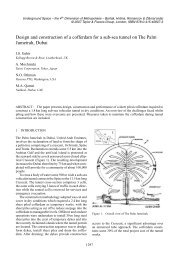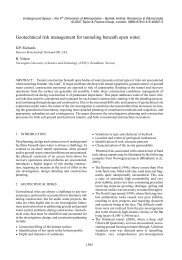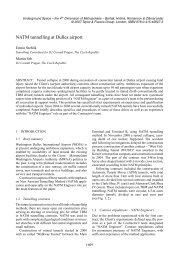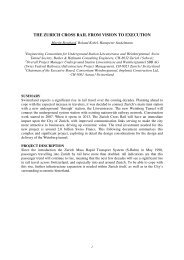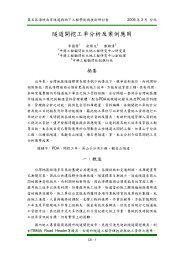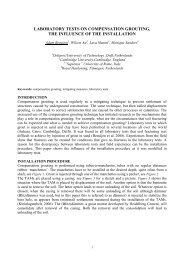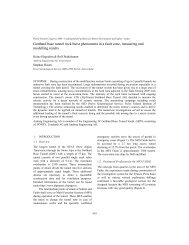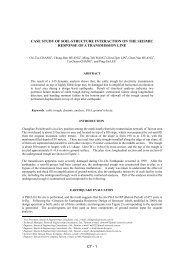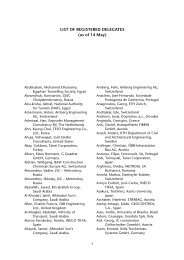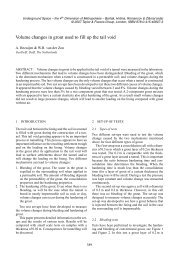Extension of RMR and Q-system in Taiwan
Extension of RMR and Q-system in Taiwan
Extension of RMR and Q-system in Taiwan
Create successful ePaper yourself
Turn your PDF publications into a flip-book with our unique Google optimized e-Paper software.
2. THE APPLICATION OF EXISTENT ROCK MASS CLASSIFICATION SYSTEMS<br />
By mak<strong>in</strong>g a comprehensive survey <strong>of</strong> major rock mass classifications worldwide, it can be traced<br />
back to the middle <strong>of</strong> 1940’s that Terzaghi proposed the rock load method. Nevertheless, <strong>in</strong> <strong>Taiwan</strong>,<br />
rock mass classifications weren’t adopted to design tunnel supports until late 1950’s. The above<br />
method was ma<strong>in</strong>ly used at that period <strong>of</strong> time <strong>and</strong> it could classify the rock mass around tunnels <strong>in</strong>to<br />
n<strong>in</strong>e rock load classes by us<strong>in</strong>g qualitative method. And it could be possible to design the so-called<br />
rigid support <strong>system</strong> by us<strong>in</strong>g the conventional, semi-empirical, <strong>and</strong> structural analysis model. General<br />
speak<strong>in</strong>g, rock load method is more suitable for shallow cover tunnels. As our underst<strong>and</strong><strong>in</strong>g <strong>of</strong><br />
tunnell<strong>in</strong>g behavior improved, the construction concept <strong>of</strong> NATM was <strong>in</strong>troduced <strong>in</strong>to <strong>Taiwan</strong> <strong>in</strong> late<br />
1970’s <strong>and</strong> has become the ma<strong>in</strong>stream nowadays.<br />
Rock mass classification <strong>system</strong>s adopted <strong>in</strong> mounta<strong>in</strong>ous tunnel eng<strong>in</strong>eer<strong>in</strong>g <strong>in</strong> <strong>Taiwan</strong> can be<br />
roughly divided <strong>in</strong>to two groups: qualitative <strong>and</strong> quantitative. For qualitative methods, rock load<br />
method <strong>of</strong> Terzaghi <strong>and</strong> rock mass classification <strong>of</strong> Austrian are the common ones; while the <strong>RMR</strong><strong>system</strong><br />
<strong>and</strong> Q-<strong>system</strong> are ma<strong>in</strong>stream for quantitative methods. Nevertheless, the rock mass<br />
classifications or classes nowadays used <strong>in</strong> <strong>Taiwan</strong> are quite different from the orig<strong>in</strong>al <strong>system</strong><br />
because <strong>of</strong> technological <strong>in</strong>novation <strong>and</strong> accumulated experience these years. Take the correspond<strong>in</strong>g<br />
<strong>RMR</strong> rat<strong>in</strong>g <strong>of</strong> the third rock mass class for <strong>in</strong>stance: Mu-Zha Tunnel <strong>of</strong> Northern Second Freeway is<br />
56~65 <strong>and</strong> new water channel <strong>of</strong> Wu-Jie is 44~56. Those were both not the proposed value <strong>of</strong> <strong>RMR</strong><strong>system</strong><br />
as 40~60. Besides, the rock mass classes adopted <strong>in</strong> tunnel groups <strong>of</strong> Northern Second<br />
Freeway had <strong>in</strong>creased by five classes to six. (Class I ~ Class VI)<br />
Furthermore, as the economical development grows up <strong>in</strong> <strong>Taiwan</strong> these years, the cases <strong>of</strong> tunnels<br />
along the western foothills <strong>in</strong>crease. For example, Lan-Tan Tunnel <strong>and</strong> Zhong-Liao Tunnel <strong>of</strong><br />
Southern Second Freeway, Pakuashan Tunnel <strong>of</strong> Hanbao-Tsaotuen Expressway, tunnel groups <strong>of</strong><br />
High Speed Railway Project, etc. were all constructed along this area. The rock formations <strong>of</strong> this area<br />
are chiefly composed <strong>of</strong> gravel layers, s<strong>and</strong>stone, <strong>and</strong> mudstone. As a result <strong>of</strong> uncompleted<br />
lithification <strong>and</strong> geologic material compositions, there are usually some characteristics <strong>in</strong> this k<strong>in</strong>d <strong>of</strong><br />
formation such as: (a) the ground is approximately <strong>in</strong>tact <strong>and</strong> has few jo<strong>in</strong>ts, (b) the strength <strong>of</strong> this<br />
ground tends to be lower, (c) weaken easily with <strong>in</strong>filtration by water. Therefore, it is unsuitable to<br />
adopt <strong>RMR</strong>-<strong>system</strong> <strong>and</strong> Q-<strong>system</strong>, which lay great emphasis on weak planes <strong>of</strong> rock mass structures,<br />
to classify the above formation. At present <strong>in</strong> <strong>Taiwan</strong>, qualitative rock mass classification <strong>system</strong>s are<br />
<strong>of</strong>ten used to classify this formation <strong>and</strong> the result <strong>of</strong> execution is quite good <strong>in</strong> general. However, the<br />
geologic material properties encountered <strong>in</strong> tunnels differ from case by case <strong>and</strong> the classification<br />
can’t always be adopted with each other.<br />
3. THE ESTABLISHMENT OF THE ROCK MASS CLASSIFICATION SYSTEM IN TAIWAN<br />
3.1 Considered factors <strong>of</strong> the skeleton<br />
Accord<strong>in</strong>g to the application <strong>of</strong> existent rock mass classification <strong>system</strong>s <strong>in</strong> <strong>Taiwan</strong>, the skeleton <strong>and</strong><br />
considered reasons <strong>of</strong> the rock mass classification <strong>system</strong> <strong>in</strong> <strong>Taiwan</strong> are described as follows:<br />
(1) At present <strong>in</strong> <strong>Taiwan</strong>, quantitative classifications such as <strong>RMR</strong>-<strong>system</strong> <strong>and</strong> Q-<strong>system</strong> are generally<br />
used while qualitative methods are adopted <strong>in</strong> the gravel layers, s<strong>and</strong>stone <strong>and</strong> mudstone. The<br />
skeleton <strong>of</strong> the rock mass classification <strong>system</strong> <strong>in</strong> <strong>Taiwan</strong> is established by follow<strong>in</strong>g the above<br />
concept. In addition, because the <strong>in</strong>fluence <strong>of</strong> cover differs from case by case, this factor is not<br />
embraced as the evaluation factor <strong>and</strong> will be properly considered <strong>in</strong> the tunnel-support suggestion<br />
if it is necessary.<br />
D7 - 2



